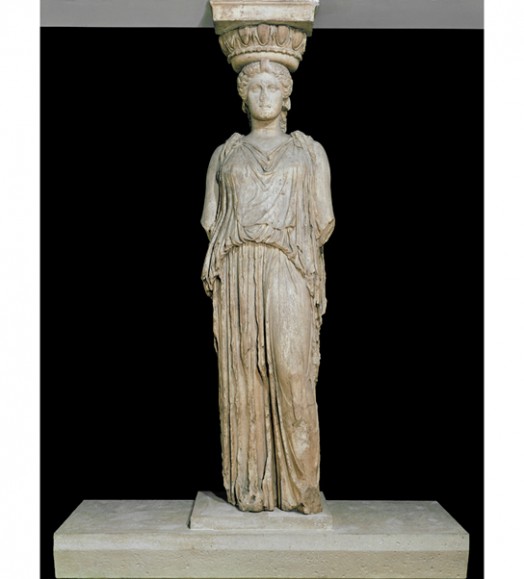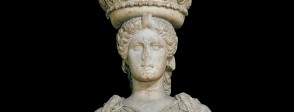
Why turn a column into a woman?
This statue of a woman is what is known in Greek architecture as a karyatid. Karyatids are female figures used in place of columns to support the upper parts of buildings. The male version is called an Atlas (plural Atlantes) after the mythical Titan or giant who held up the sky. Behind such figures stands the Greek fascination with the human body and its reflection even in the inanimate world: the lifeless column is transformed into a living human being who carries the weight of the building, just as women in Greece every day bore heavy jars of water on their heads as they brought it from the fountain to the house.
Early Greek temples
After the collapse of the Mycenaean civilisation in Greece in the 1100s BC, there followed a period of relative poverty and isolation. During this so-called Dark Age, there is evidence for religious buildings from the early 8th century BC. Some of these were small, horseshoe-shaped buildings with a porch at the front supported by posts while others, such as the temple of Hera on the island of Samos, were long rectangular buildings surrounded by wooden posts. These early temples used stone or mud brick for their walls and had roofs made of wood and thatch. Some archaeologists believe that these wooden origins survive in certain features of later stone temples. The vertical grooves or flutes on columns are thought to represent the marks of the woodworking tool used to strip off the bark and smooth out irregularities in the timber.
It was the Egyptians and other peoples of the Middle East that inspired Greeks to construct large buildings completely from stone, and from them they also learned the techniques of carving and cutting. The earliest Greek temples built entirely in stone date from around 600 – 580 BC. By this time, the Greeks had renewed their contacts with other parts of the Mediterranean world. They had adopted the alphabet of the Phoenicians of the coast of Lebanon for writing their own Greek language and by 620 BC had well-established trading contacts with Egypt via the trading city of Naukratis in the Nile delta.
What were temples for?
This karyatid comes from a temple called the Erechtheion, which was built in the last quarter of the 5th century BC on the hill known as the acropolis in the centre of Athens. She is probably a generic representation of one of the aristocratic maidens that are known to have served in the cult of Athena, to whom the building was dedicated. Like all Greek temples, the Erechtheion was regarded as the house of the god, containing a cult statue and acting as a store house for treasures and for offerings made by individuals and by the city. The main focus of rituals performed in honour of the god was not, however, the temple, but the altar, which stood outside the temple, normally at the east end. It was at the altar that animals were sacrificed and parts of their bodies burned as divine offerings before the rest of the meat was cooked and eaten by the festive community as part of the celebration.
The Erechtheion was a particularly complicated temple as it actually housed several sacred areas for different gods. The ancient olive wood statue of Athena Polias (Athena of the city) stood inside. This was the destination of the annual Panathenaic procession, a festival in Athena’s honour which was a demonstration of the city’s devotion to its patron goddess, of the wealth and power of Athens and of its civic identity – the same ideas that also inspired the building of the Parthenon that stood across from the Erechtheion. The other gods housed in the Erechtheion were also associated with the founding of Athens and its early history. This reminds us that temples were built not just for religious reasons. The effort and expense of building a temple was also harnessed to communicate the identity and power of the city in whose territory it stood.
More information
Karyatid from the Erechtheion
http://www.britishmuseum.org/explore/highlights/highlight_objects/gr/c/caryatid_from_the_erechtheion.aspx
An Ionic column from the Erechtheion
http://www.britishmuseum.org/explore/highlights/highlight_objects/gr/i/ionic_column_-_the_erechtheion.aspx
Greek architecture
Brief overview of Greek architecture.
http://www.metmuseum.org/toah/hd/grarc/hd_grarc.htm
Greek architecture
Comprehensive introduction to Greek architecture.
http://en.wikipedia.org/wiki/Ancient_Greek_architecture#History
Civilisation during the European Enlightenment
British Museum online tour: the idea of civilisation during the European Enlightenment.
http://www.britishmuseum.org/explore/online_tours/britain/enlightenment_civilization/enlightenment_art.aspx
Neoclassicism in the 1700s
Introduction to Neoclassicism in the 1700s.
http://www.metmuseum.org/toah/hd/neoc_1/hd_neoc_1.htm
BBC History: Lord Elgin – saviour or vandal?
http://www.bbc.co.uk/history/ancient/greeks/parthenon_debate_01.shtml
More information
-
Karyatid from the Erechtheion
Source: britishmuseum.org
-
An Ionic column from the Erechtheion
Source: britishmuseum.org
-
Greek architecture
Brief overview of Greek architecture.
Source: metmuseum.org
-
Greek architecture
Comprehensive introduction to Greek architecture.
Source: en.wikipedia.org
-
Civilisation during the European Enlightenment
British Museum online tour: the idea of civilisation during the European Enlightenment.
Source: britishmuseum.org
-
Neoclassicism in the 1700s
Introduction to Neoclassicism in the 1700s.
Source: metmuseum.org
-
BBC History: Lord Elgin – saviour or vandal?
Source: bbc.co.uk


